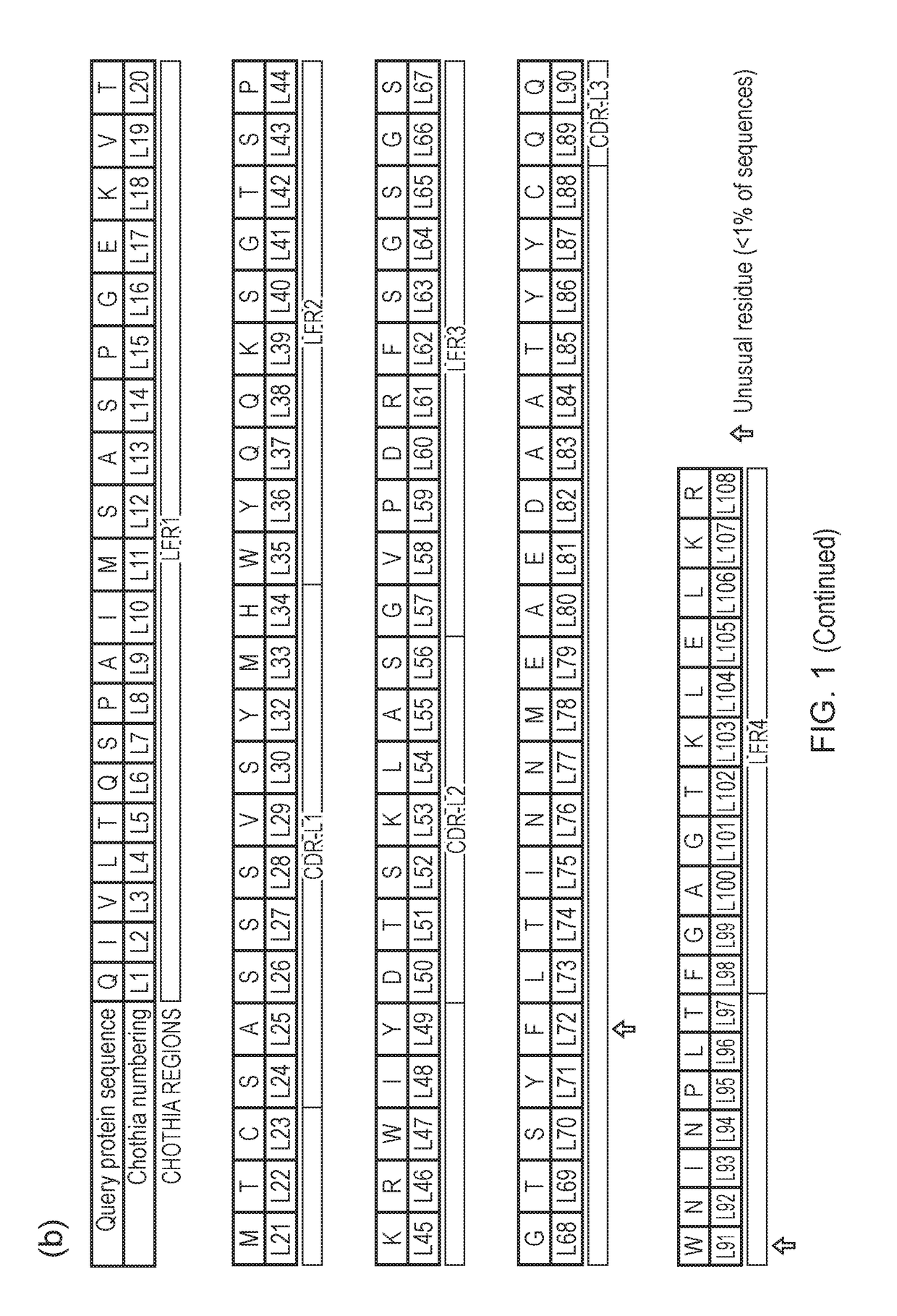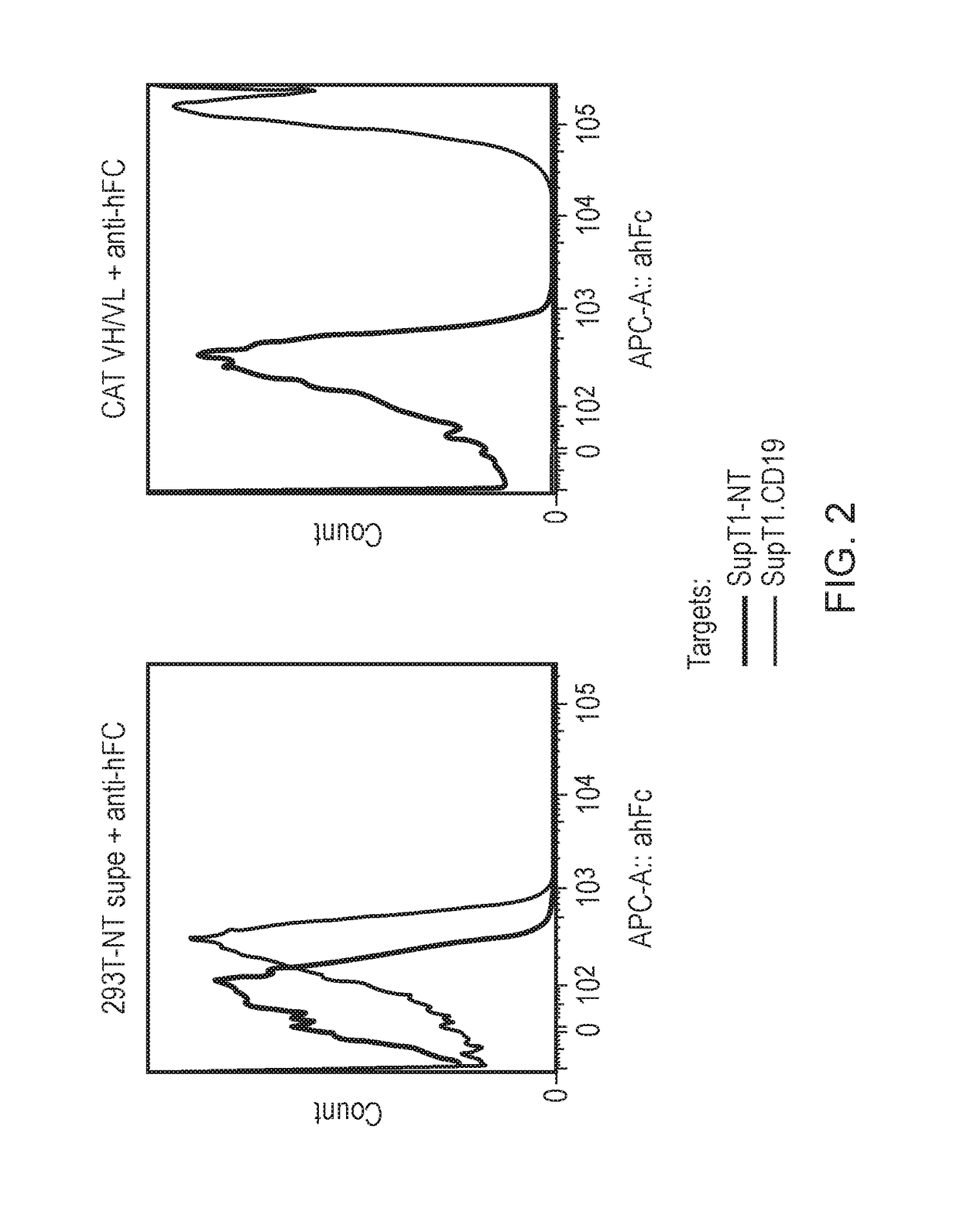Chimeric Antigen Receptor (CAR) Comprising a CD19-Binding Domain
- Summary
- Abstract
- Description
- Claims
- Application Information
AI Technical Summary
Benefits of technology
Problems solved by technology
Method used
Image
Examples
example 1
f VH and VL and Demonstration of CD19 Binding
[0113]The VH and VL were cloned from a mouse anti-CD19 monoclonal antibody and fused in frame with the human kappa constant region and the human IgG1 constant region. These chimeric heavy and light chains were cloned into an expression vector and used to transfect 293T cells. The subsequent produced antibody was used to stain SupT1 cells (a T-cell line which is CD19 negative), and SupT1 cells which have been engineered to be CD19 positive. This staining shows specific binding of the CD19 (FIG. 2).
example 2
tion that the VH / VL can Form an scFv which Binds CD19
[0114]It was then investigated whether the cloned VH and VL could bind CD19 in a scFv format. The VH and VL were cloned as an scFv in two orientations: VH-VL and VL-VH, where the two variable regions were separated by a linker comprising of (SGGGG)4. These scFv were cloned into a non-signalling CAR co-expressed with truncated CD34 as shown in FIG. 3a. Briefly, this comprises of a signal peptide, scFv, hinge-CH2-CH3 of human IgG1, the CD8 transmembrane domain, the first 12 residues of the CD8 endodomain, a FMD-2A peptide TeV, truncated human CD34. To allow comparison, scFv from fmc63, and scFv from another anti-CD19 hybridoma 4g7, were cloned in the same format in both VH-VL and VL-VH orientations.
[0115]In this way, several parameters can be studied: (1) the binding of target antigen to the CAR by use of recombinant cognate target antigen fused to murine Fc, unencumbered by internalization of the receptor due to signalling; (2) The...
example 3
Comparison of CAT19 CAR Function Against Fmc36 CAR
[0119]The CAT scFv in HL orientation was cloned into a CAR scaffold designed by Campana (Imai et al (2004) Leuk. Off. J. Leuk. Soc, Am. Leuk, Res. Fund. UK 18:676-684). Effectively the fmc63 scFv was replaced with a CAT scFv, and compared with the original fmc63 based CAR. This CAR comprises a signal peptide, the scFv, a CD8 stalk spacer and transmembrane and 41BB and Zeta endodomains. The amino acid sequences of the CAT CAR and fmc63 CAR are given below:
>CAT19_CAR(SEQ ID No. 10)MGTSLLCWMALCLLGADHADAQVQLQQSGPELVKPGASVKISCKASGYAFSSSWMNWVKQRPGKGLEWIGRIYPGDEDTNYSGKFKDKATLTADKSSTTAYMQLSSLTSEDSAVYFCARSLLYGDYLDYWGQGTTLTVSSGGGGSGGGGSGGGGSQIVLTQSPAIMSASPGEKVTMTCSASSSVSYMHWYQQKSGTSPKRWIYDTSKLASGVPDRFSGSGSGTSYFLTINNMEAEDAATYYCQQWNINPLTFGAGTKLELKRSDPTTTPAPRPPTPAPTIASQPLSLRPEACRPAAGGAVHTRGLDFACDIYIWAPLAGTCGVLLLSLVITLYCKRGRKKLLYIFKQPFMRPVQTTQEEDGCSCRFPEEEEGGCELRVKFSRSADAPAYQQGQNQLYNELNLGRREEYDVLDKRRGRDPEMGGKPRRKNPQEGLYNELQKDKMAEAYSEIGMKGERRRGKGHD...
PUM
| Property | Measurement | Unit |
|---|---|---|
| Fraction | aaaaa | aaaaa |
| Fraction | aaaaa | aaaaa |
| Fraction | aaaaa | aaaaa |
Abstract
Description
Claims
Application Information
 Login to View More
Login to View More - R&D
- Intellectual Property
- Life Sciences
- Materials
- Tech Scout
- Unparalleled Data Quality
- Higher Quality Content
- 60% Fewer Hallucinations
Browse by: Latest US Patents, China's latest patents, Technical Efficacy Thesaurus, Application Domain, Technology Topic, Popular Technical Reports.
© 2025 PatSnap. All rights reserved.Legal|Privacy policy|Modern Slavery Act Transparency Statement|Sitemap|About US| Contact US: help@patsnap.com



